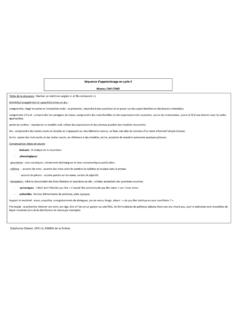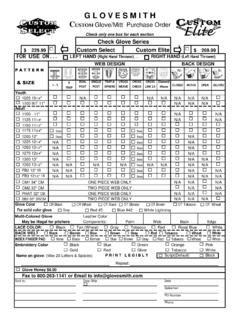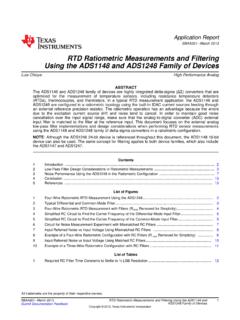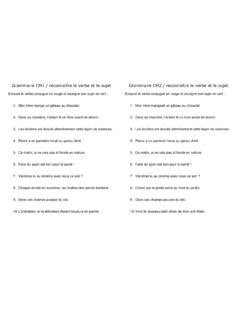Transcription of Withdrawal of SANS 1200 and SANS 10120 as a South African ...
1 Civil Engineering March 201631 INTRODUCTIONThe Standards Act of 2008 requires the South African Bureau of Standards to develop, issue, promote, maintain, amend or withdraw South African National Standards serving the stand-ardisation needs of the South African community. South African National Standards, as is the case for International Standards, are reviewed every five years to ensure continued market relevance. The South African Institution of Civil Engineering (SAICE) developed the SANS 1200 (Standardised Specification for Civil Engineering Construction) and associated SANS 0120 (Code of Practice for use with Standardised Specifications for Civil Engineering and Contract Documents) series in the late 1970s and early 1980s, with the support of the South African Federation (now Forum) of Civil Engineering Contractors (SAFCEC) and the South African Association of Consulting Engineers (SAACE, now Consulting Engineers South Africa (CESA)), and handed it over to the South African Bureau of Standards (SABS) to publish and maintain.
2 These series of standards, however, stagnated in that they were not further developed and most of the parts were not amended to reflect changes in technologies, practices, procedures, materials and methods since their Withdrawal of SANS 1200 and replacement with SANS 2001 has been on the standards development agenda for many years. TC 1098 has, in terms of SANS 1-1, agreed to the Withdrawal of SANS 1200 and SANS 10120 during April 2016, despite the fact that not all the SANS 1200 standards had been converted to the SANS 2001 series. Although SANS 1200 documents will no longer enjoy South African national standard status, these standards may nevertheless continue to be purchased from the SABS Sales Office. SANS 2001 CONSTRUCTION STANDARDS An overview of SANS 2001 The different parts of SANS 2001 each address a specific component of construction works.
3 The prime purpose in the production of these standards is to create a set of standards which are generally applicable to construction works, and which can be readily modified to make them applicable to par-ticular works. Accordingly, the SANS 2001 family of standards provides technical descriptions of the standard of materials and workmanship that will be used in the works. These standards do not make reference to the actions of those responsible for executing the works or the parties to a contract, to the con-straints relating to the manner in which contract work is to be performed. Neither do they deal with the commercial arrange-ments of such contracts. Parts of SANS 2001 are commonly applied in three dif-ferent of SANS 2001 in contractsContract documents for engineering and construction works need to be developed in accordance with the provisions of SANS 10 8 45 -2 (Construction procurement 2: Formatting and compi-lation of procurement documents) which replaces SANS 10403 (Formatting and compilation of procurement documents).
4 Procurement documents developed in accordance with this standard comprise a number of component documents dealing with different topics grouped together in a logical sequence. The content of each component document should be such that, as far as possible, each subject matter is addressed only once in the procurement document and in its logical location. The com-ponent document scope of work is defined as the document that specifies and describes the goods, services, or engineering and construction works which are to be provided, and any other Withdrawal of SANS 1200 and SANS 10120 as a South African National StandardAlex van Niekerk Pr EngPlanning, Toll and Traffic Dr Ron WatermeyerChairman of SABS TC 1098 (Buildings and Civil Engineering 2016 Civil EngineeringTable 1: Direct and indirect references to SANS 2001 in SANS 10400 Part of SANS 2001 CommentsBE1 Earthworks (general)Referenced in SANS Site clearanceReferenced as a where necessary requirement in SANS Concrete works (structural)*Referenced as an alternative to SANS 2001-CC2 to enable concrete components and elements which are designed by the rules provided in SANS 10400 to be constructed.)
5 Typically used where concrete on a site is required for structures designed by competent persons and structures which are designed using the rules provided in SANS Concrete works (minor works)This part of SANS 2001 provides construction rules for concrete work designed in accordance with the design rules contained in: SANS 10400-H (foundations) lightly loaded surface beds SANS 10400-J (floors) water-resistant floors of concrete construction and plain concrete impervious floors of limited size SANS 10400-M (stairways) stairways SANS 10400-P (drainage) conservancy and septic tanks SANS 10400-Q (non-water means of sanitary disposal) ventilated improved pit 2001-CC2 also provides rules for in-fill concrete in masonry walls. This part of SANS 2001 provides only for rough finishes to the concrete.
6 SANS 2001-CC1 is used where a different finish is Installation of glazing in window and door frames*The design rules for glazing contained in SANS 10400-CG1 (glazing) require that glazing either be installed in accordance with the requirements of SANS 10400-CG1 or in accordance with a suitable method described in SANS Masonry walling*This part of SANS 2001 provides construction rules for masonry designed in accordance with the design rules contained in: SANS 10400-H (foundations) foundation walls SANS 10400-K walls SANS 10400-P (drainage) conservancy and septic tanks SANS 10400-Q (non-water means of sanitary disposal) ventilated improved pit part of SANS 2001 requires: in-filling concrete to comply with the requirements of SANS 2001-CC2 joints in plaster provided at the interface between a soffit and wall to be in accordance with SANS design rules for masonry walls contained in SANS 10400-K (walls) require that in-fill concrete be in accordance with SANS Strip footings, pad footings and slab-on-the-ground foundations for masonry walling*This part of SANS 2001 provides construction rules for foundations supporting masonry walls and surface beds / slab on the ground designed in accordance with the design rules contained in SANS 10400-H (foundations).
7 This part of SANS 2001 references Part BE1, BS1, CC1, CC2 and CM1. Material placed beneath foundations is required to comply with the requirements of SANS 2001-BE1. Where specified by the user clearing is required to be carried out as specified in SANS 2001-BS1. All concrete work in foundations and surface beds is required to comply with the provisions of SANS 2001-CC1 or SANS 2001-CC2. All masonry work in foundations is required to comply with the provisions of SANS Structural steelwork*This part of SANS 2001 does not cover roof and side cladding, or the detailed aspects of sundry items such as handrails, ladders, steel flooring and the like, neither does it cover protection of steel-work against corrosion or Structural timberwork (flooring)*This part of SANS provides construction rules for suspended timber floors designed in accordance with the design rules contained in SANS 10400-J (floors).
8 CT2 Structural timberwork (roofing)This part of SANS 2001 provides construction rules for soft-wood roofing and ceiling assemblies designed in accordance with the design rules contained in SANS 10400-L (roofs).DP2 Medium pressure pipelinesSANS 10400-W (fire installations) requires that all fire installation pipework be constructed in accordance with the relevant requirements of SANS 2001-DP2 or installation pipework installed above ground or within the structure of a building is required to be me-tallic pipes and fittings complying with the relevant requirements of SANS 2001-DP2 and SANS Below groundwater installationsEM1 Cement plasterThis part of SANS 2001 provides construction rules for the plastering of masonry walls designed in accordance with the design rules contained in: SANS 10400-H (foundations) foundation walls SANS 10400-K walls SANS 10400-P (drainage) conservancy and septic tanks SANS 10400-Q (non-water means of sanitary disposal) ventilated improved pit fire resistance of plaster quoted in SANS 10400-T (fire protection) assumes that the plaster is in accordance with the provisions of SANS 2001-EM1.
9 * SANS 10400-B (structural design) states that Parts CC1, CG1, CM1, CM2, CS1 and CT1 of SANS 2001 may be used by competent persons to specify construction requirements for rational designs to satisfy Engineering March 201633WP I&E ad 12016/02/08 2:55 PMrequirements and constraints relating to the manner in which the contract work is to be performed. Different families of SANS standards are used to compile the scope of works: NSANS 2001 establishes generic specifications of the construc-tion works for earthworks, site clearance, concrete works, glazing, masonry walling and strip footings, structural steelwork, structural timberwork, pipe bedding, pressure pipelines, cable ducts, sewers, stormwater drainage and pipe jacking, and NSANS 1921 establishes generic requirements and constraints relating to the manner in which the works are are modified for a specific purpose under a contract by specification data in the scope of work.
10 Application of SANS 2001 in National Building Regulations Sub-regulation A14(1)(a) (Construction) of the National Building Regulations requires that the construction of any building or element be such that the building or element as constructed does not compromise the design intent of any design solution that satisfies the requirements of a functional regulation. This sub-regulation is deemed to be satisfied if such construction satisfies the requirements of the relevant part of SANS 10400. SANS 10400 establishes construction rules by reference to parts of SANS 2001 for use in conjunction with design rules. The default requirements of SANS 2001, or the prescribed parameters contained in parts of SANS 10400, are adequate for solutions which are arrived at by applying these design parts of SANS 2001 which are currently directly and in-directly referenced in SANS 10400 are indicated in Table of SANS 2001 in the NHBRC (National Home Builders Registration Council) warranty schemeThe recently revised NHBRC s Home Building Manual 2015 establishes the means by which compliance with its technical requirements relating to its warranty scheme (5-year major structural defects and 12-month roof leakage warranty) can be demonstrated.





